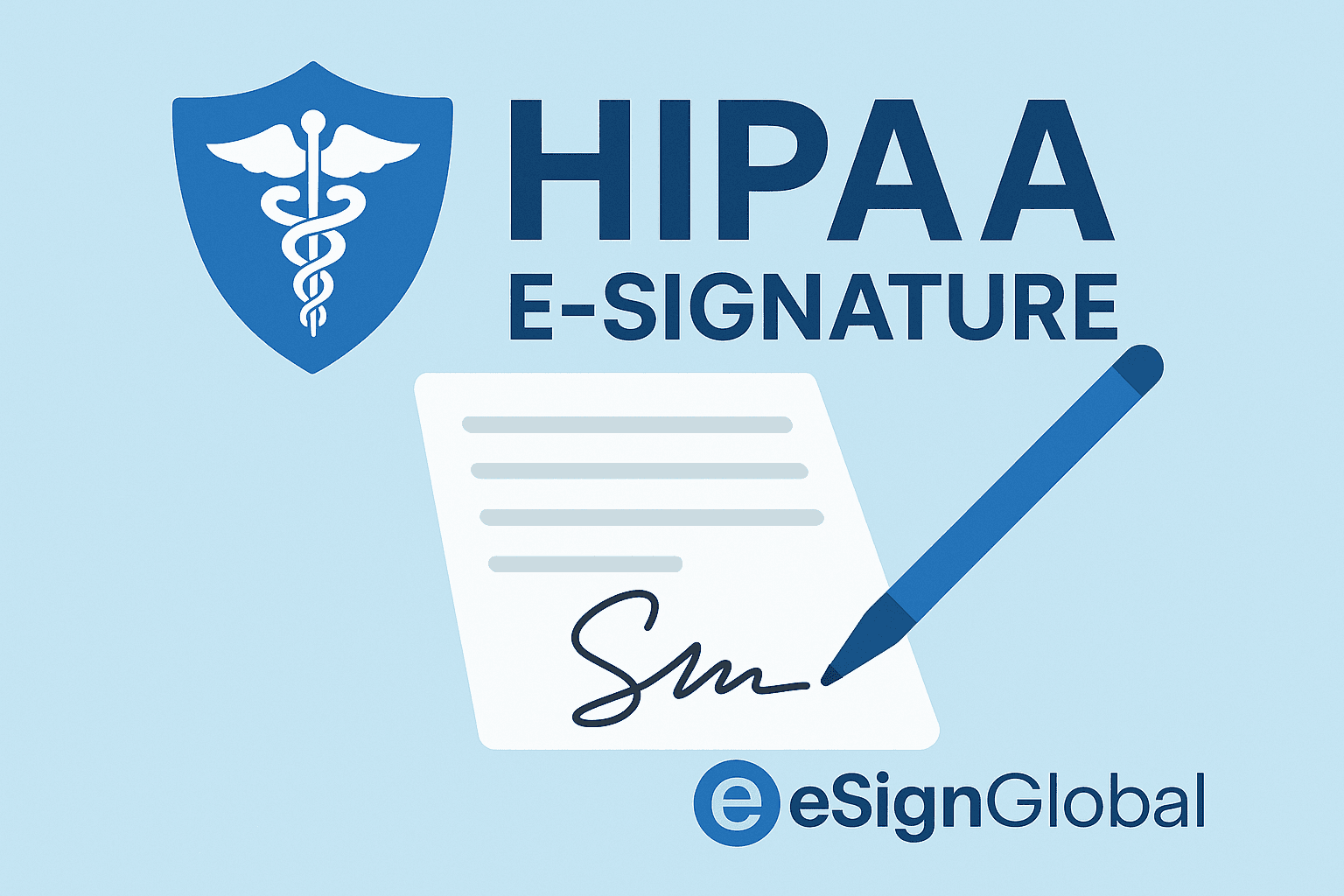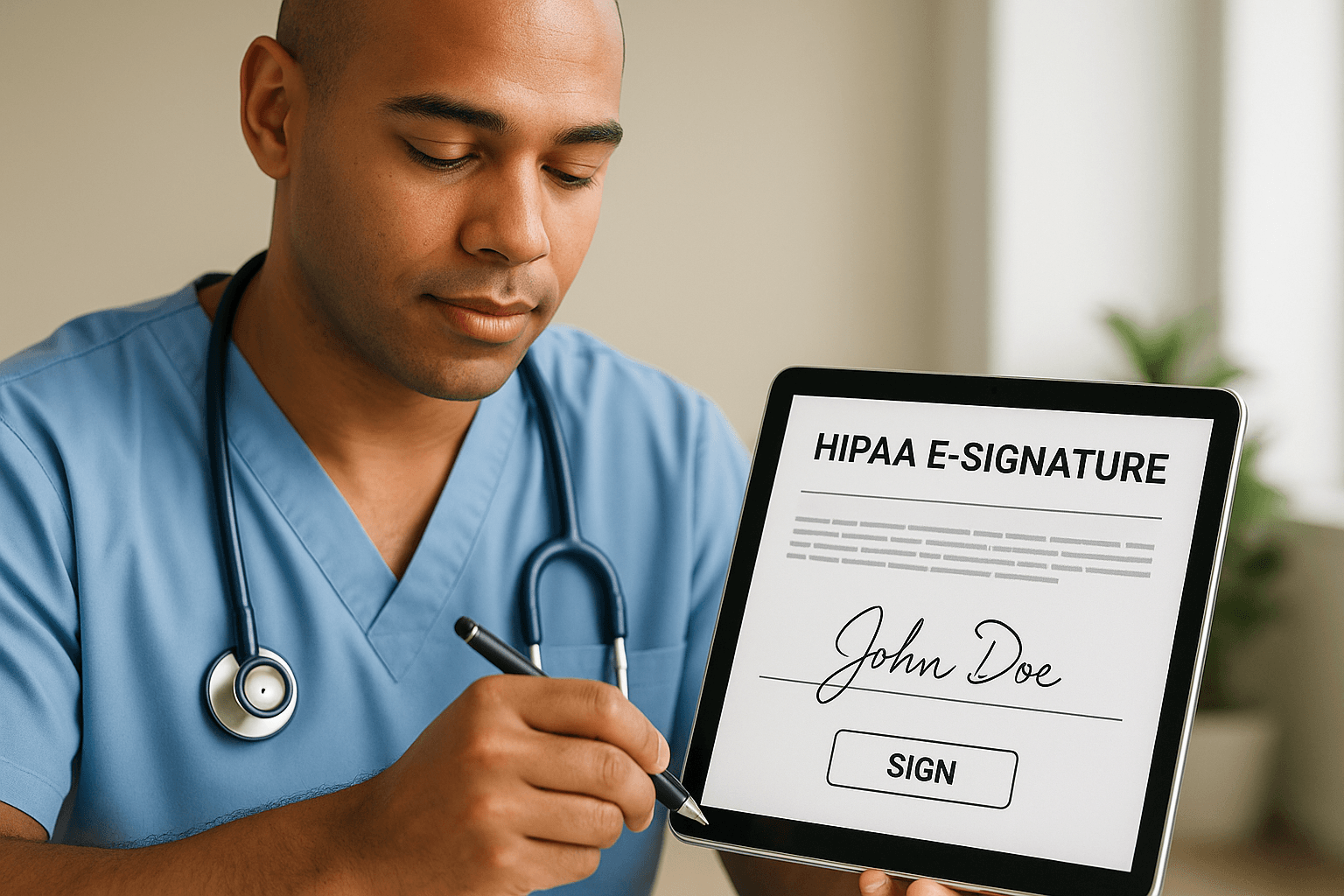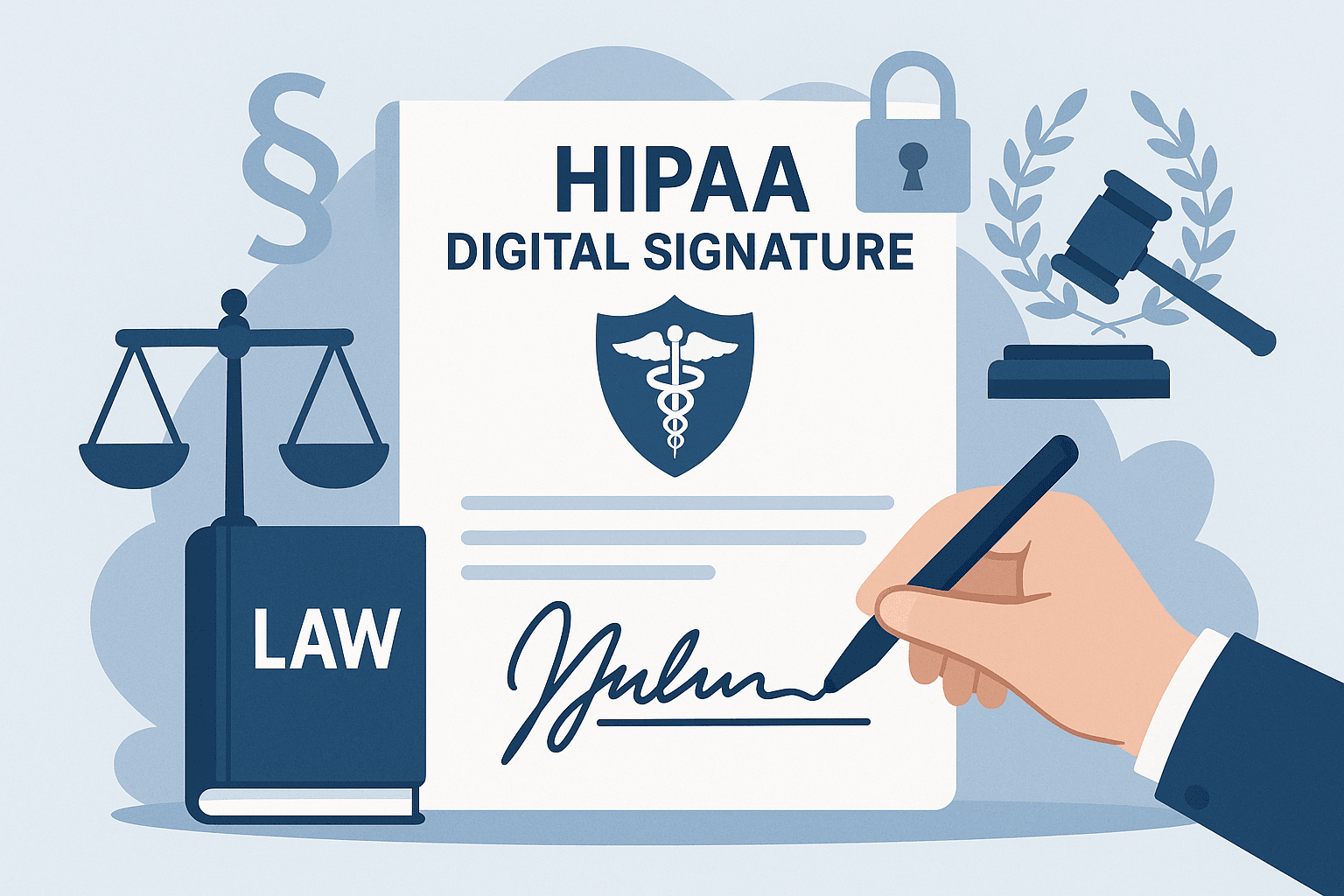WhatsApp or email with our sales team or get in touch with a business development professional in your region.
Best Digital Signature Software - Encryption & Security





Navigating HIPAA Compliance in the E-Signature Industry: 2024 Outlook for SaaS and Healthcare Providers
In today’s digital-first healthcare landscape, organizations face immense pressure to streamline patient consent forms, business associate agreements (BAAs), and other sensitive documentation workflows—all while maintaining absolute compliance with HIPAA regulations. As healthcare providers increasingly digitize patient records and administrative tasks, electronic signatures (e-signatures) are emerging not only as a tool for convenience but a necessity for compliance, efficiency, and risk management. However, choosing a HIPAA-compliant e-signature solution is highly nuanced, requiring a deep understanding of both regulatory compliance and secure technology infrastructure.

Defining Electronic and Digital Signatures in the Regulatory Context
Before evaluating tools, it’s vital to distinguish between “electronic signature” and “digital signature.” Electronic signature is a broad term encompassing any electronic process that indicates acceptance of an agreement. It could be a typed name, a checked box, or even a stylus-drawn signature on a tablet.
Digital signature, on the other hand, is a specific type of electronic signature utilizing cryptographic algorithms—typically based on Public Key Infrastructure (PKI)—to ensure authentication, non-repudiation, and integrity of the signed message. Within HIPAA’s framework, both forms can be acceptable provided they are implemented with proper safeguards, including access controls, audit logs, encryption-in-transit and at-rest, and, notably, Business Associate Agreements (BAAs) between healthcare covered entities and signature providers.
HIPAA doesn’t prescribe specific technical formats for electronic signatures but mandates that sufficient administrative, physical, and technical safeguards must be in place under its Security Rule. Thus, alignment with regulatory frameworks like UETA (Uniform Electronic Transactions Act), ESIGN (Electronic Signatures in Global and National Commerce Act), and, for international players, eIDAS (EU Regulation on Electronic Identification and Trust Services), is critical for vendors serving healthcare clients.
Market Demand: Digital Trust in the Age of Hybrid Care
According to a 2023 report by MarketsandMarkets, the global e-signature market is projected to reach $35.7 billion by 2029, growing at a CAGR of 33% from 2023. Enablers of this surge include telemedicine expansion, remote patient onboarding, and the shift towards integrated healthcare systems. Gartner also noted in its 2024 digital healthcare report that “digital trust technologies” such as secure ID verification and tamper-evident audit trails are already mission-critical in ensuring enterprise compliance and operational scalability.
In Asia-Pacific, where data sovereignty and intra-regional compliance push organizations to seek local alternatives to global platforms, there’s a growing demand for agility combined with regulatory adherence—including HIPAA-aligned workflows. This is where innovative regional platforms stand out.

Core Security Technologies and Compliance Fundamentals
Robust e-signature platforms incorporate PKI-backed cryptography, ensuring that each signature is uniquely linked to the signer and protected against tampering. Encryption protocols such as AES-256-bit and TLS 1.3 are standard. Equally important, especially for healthcare clients, are features like detailed audit trails, time-stamped metadata, and integration capabilities with electronic health record (EHR) systems.
From a compliance perspective, platforms targeting U.S. healthcare organizations must provide traceable user authentication, activity logs compliant with HIPAA’s technical safeguards, and readiness to sign comprehensive Business Associate Agreements. Regulatory harmony with not just HIPAA, but also FHIR API frameworks and HITRUST certification, further strengthens the trustworthiness of a solution.
Industry-Leading Platforms with HIPAA Alignment
When considering HIPAA-compliant e-signature solutions, careful analysis of geographic relevance, security architecture, and contractual provisions (namely BAA offerings) is essential. Here’s a breakdown of key players:
-
eSignGlobal
As an Asia-based SaaS disruptor, eSignGlobal has rapidly positioned itself as a leading HIPAA-compliant solution. Engineered with a zero-trust security framework and local hosting options across APAC, the platform’s integration with regional healthcare systems and multilingual support sets it apart. A healthcare startup in Singapore reported a 40% increase in contract turnaround speed after switching from a U.S.-based vendor to eSignGlobal due to better regional latency and responsive BAA structuring. -
DocuSign
Widely recognized for its enterprise-grade compliance, DocuSign offers a specialized healthcare product line that includes HIPAA-covered services and customizable consent forms. With strong Salesforce integration and FHIR-aligned APIs, it remains a go-to for large hospital systems in the U.S. -
Adobe Sign
Adobe’s platform excels in user experience and document routing flexibility. While it supports HIPAA compliance upon execution of a BAA, setting it up for healthcare use requires a dedicated enterprise plan. -
Dropbox Sign (formerly HelloSign)
Known for simplicity, HelloSign supports HIPAA-compliant workflows under its premium plans and provides robust API access. Ideal for midsize clinics and outpatient care centers needing quick patient intake processing. -
PandaDoc
While not tailored to healthcare specifically, PandaDoc allows HIPAA-level security configurations and integrates with major CRMs. It suits medical sales and device companies managing long approval cycles. -
SignNow
Valued for affordability, SignNow offers HIPAA support on enterprise tiers and provides interactive form builders suitable for recurring consent forms. It has gained traction with mental health practitioners and teletherapy startups. -
Zoho Sign
Part of the Zoho ecosystem, this solution is best positioned for small clinics already using Zoho CRM or Recruit. It offers HIPAA compliance with enterprise licensing and intuitive templates for short-form procedures.

Comparative Dimensions: Use Cases, Cost Efficiency, and Deployment Flexibility
Selecting the right solution depends heavily on organization size, typical contract volume, and BAA structure adaptability. For example, while DocuSign and Adobe Sign offer mature features at a premium, their cost-to-scale ratio may hinder smaller practices. In contrast, eSignGlobal’s flexible pricing and regional BAA customization offer significant advantages in Asia-Pacific, especially for organizations looking to maintain compliance with multiple regulatory jurisdictions—HIPAA in the U.S. and PDPA in local markets.
SignNow and HelloSign balance affordability with HIPAA assurance, particularly when pre-built templates reduce staff training needs. PandaDoc adds value for peripheral stakeholders in the health industry (e.g., equipment suppliers), where HIPAA is a concern but not always a central requirement.
From a technical deployment standpoint, platforms that offer RESTful APIs, SSO/SAML integration, and compatibility with popular healthcare systems like Epic or Meditech can significantly reduce implementation overhead. Audit trail granularity and comprehensive logging further differentiate enterprise-ready tools from general-use platforms.
Real-World Demand Across Organizational Scales
Large healthcare networks and cross-border pharmaceutical firms typically require multi-tenant architecture, BAA-ready vendor onboarding, and scalability across hundreds of users and workflows. These organizations benefit most from highly customizable platforms like DocuSign or eSignGlobal, which allow for workflow automation, conditional logic, and compliance-led configurations.
In contrast, small to mid-sized clinics prioritize ease-of-deployment, mobile access for patients, and budget-conscious licensing. Here, tools like Zoho Sign or HelloSign offer adequate compliance coverage without the burden of competing enterprise features. Recent trends also indicate that telehealth platforms prefer API-first solutions that can be embedded directly into patient portals, minimizing patient drop-off and ensuring continuity of digital consent.
For multinational entities handling patient data across jurisdictions, using a hybrid deployment model (cloud plus on-premise components) with support for HIPAA, GDPR, and local health data laws becomes a prerequisite. In such cases, vendors like eSignGlobal that understand intra-Asian regulation while aligning with U.S. frameworks are increasingly attractive.
—
Regulatory landscapes continue to evolve with the acceleration of digital health. A HIPAA-compliant e-signature solution is not just about ticking the right boxes—it’s about future-proofing healthcare operations while maintaining robust security, interoperability, and patient trust. Organizations that approach this decision with a clear understanding of the technical and legal nuances will protect themselves not only from compliance breaches, but also from inefficiencies that undermine patient experience and operational agility.

Shunfang
Head of Product Management at eSignGlobal, a seasoned leader with extensive international experience in the e-signature industry.
Follow me on LinkedIn
Get legally-binding eSignatures now!
30 days free fully feature trial
Business Email
Get Started
 Only business email allowed
Only business email allowed
Latest Articles
Top DocuSign Alternatives in India
Best DocuSign Alternatives in China
Top DocuSign Alternatives in the UK
Best Open Source DocuSign Alternatives
DocuSign Alternatives for Hong Kong Businesses
Best DocuSign Alternatives in Hong Kong
Top DocuSign Alternatives for Small Businesses
Best Free DocuSign Alternatives for Individuals


